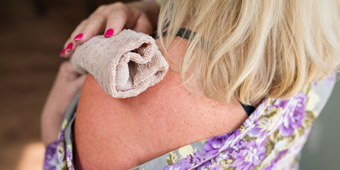Here’s the Skinny On Skin Infections

Find Your Perfect Match
Answer a few questions and we'll provide you with a list of primary care providers that best fit your needs.
Your skin is like a protective coating that prevents infection from entering your body. But sometimes a break in the skin lets infections in. Here’s a review of the most common skin infections.
Bacterial Infections
Cellulitis and other staph infections, including MRSA are common yet should not be ignored. Bacteria gets into the deep layers of your skin through cracks or wounds, and into the tissue below the skin. It makes your skin look swollen and red and become warm and painful. You might also get a fever. These infections are usually found on your lower legs, face and/or arms. With proper treatment of an oral antibiotic, cellulitis and other staph infections will improve significantly in a few days. But without antibiotics they can spread quickly and become life-threatening.
Impetigo is a contagious skin infection common in children around ages 2 to 6. The bacteria usually get into the skin through a cut, scratch, or insect bite. Impetigo looks like small red bumps or pimples surrounded by red skin. It appears on your face, arms, and legs. When the sores break open they cause a crust that itches. Scratching the sores causes them to spread across your body. The infection can spread to others who come in contact with the sores, or who touch discharge from the infected person’s nose. Impetigo is treated with antibiotics and goes away within weeks or sooner.
Having good hygiene is the number one step in prevention.
Viral Infections
Shingles is caused by the same virus that causes chickenpox. Once you get chickenpox the virus stays in your body. Many years later, usually when you’re in your 50s or older, the virus can cause shingles. The first symptoms of shingles are burning or shooting pain and tingling or itching, usually on one side of the face or body. The pain can be mild to severe. Up to two weeks later (sometimes within just a day) a rash or blisters appear, usually as a stripe. You might also get a fever, headache, chills, and/or upset stomach. It’s important to see a doctor for advice and treatment.
The worst cases of shingles cause severe pain, vision loss, and hearing or balance problems. Such issues can be temporary or permanent. Typical cases of shingles go away in two to four weeks.
 Shingles isn’t contagious, but if you’ve never had chickenpox you can catch it from someone who has shingles. Prompt treatment of shingles within the first couple of days of the rash can significantly lessen the severity of symptoms and potential long-term complications. There are also vaccines to help prevent shingles.
Shingles isn’t contagious, but if you’ve never had chickenpox you can catch it from someone who has shingles. Prompt treatment of shingles within the first couple of days of the rash can significantly lessen the severity of symptoms and potential long-term complications. There are also vaccines to help prevent shingles.
Herpes simplex is a virus that causes pustules on the skin, which get crusty once they open. Once you get herpes you will have the virus for life. There currently is no cure. Cold sores (also called fever blisters) and genital herpes are two forms of the virus. Over-the-counter medication for cold sores can speed the healing. Oral prescription medication is available for genital herpes to help manage outbreaks. Herpes simplex is contagious. It spreads easily through skin-to-skin contact including saliva, handshakes, kissing, and unprotected sex.
Warts are a viral infection that frequently appear on your hands, feet, elbows, and near the knees. A tiny cut or scratch on the skin can provide the opening needed to get a wart. The HPV virus that causes warts can be passed from person to person by close physical contact or from touching something that a person with a wart touches, like a towel, bathmat, or a shower floor. When warts are transmitted sexually they appear in the genital area. Over-the-counter medications are available to treat warts, but they should not be used on the face or genital area. Some warts require treatment by your physician and could take from several months to years to go away.
Fungal Infections
Fungi are usually found in moist areas of your body where skin meets skin: between the toes, in the genital area, under the breasts, and in excessive skin folds. Common fungal infections are:
Athlete’s foot usually occurs in the space between your toes. It causes itching, burning, scaly skin. Over-the-counter antifungal creams usually are all that is needed to treat athlete’s foot. For more serious cases, see your doctor for a prescription medication. It can be spread through contaminated floors, towels, or clothing.
Ringworm has nothing to do with a worm. This skin infection gets its name because of the way it looks, like a red ring on the skin (the skin is clear inside the ring). The rash is red and itchy and is spread by skin-to-skin contact with a person or animal who has the infection. An over-the-counter antifungal cream will effectively treat mild cases of ringworm. More severe cases require oral prescription medication and may take several weeks to clear up.
Jock itch gets its name because it is common in athletes and people who sweat a lot. This skin infection is an itchy, red rash on your genitals, inner thighs, and buttocks. Like other fungal infections, it occurs in warm, moist areas of your body, and it is spread by skin-to-skin contact or by sharing contaminated towels or clothing. An over-the-counter ointment, lotion, powder or spray often clears it up quickly. If not, or if it keeps coming back, your doctor may prescribe a stronger medication.
Yeast infections (Candidiasis). Candida yeast lives in your mouth, digestive tract, and vagina, and typically causes no harm. But under certain conditions (hot, humid weather; tight clothing; poor hygiene; infrequent diaper or underwear changes) the yeast can become a rash with a thick, white, pasty residue. It causes itching and burning in the vaginal area. These infections are more common in women who are taking antibiotics, have a weakened immune system, high levels of estrogen, or uncontrolled diabetes.
Treating a yeast infection requires an antifungal medication for up to a week. Some are available over-the-counter, but some doctors prefer a prescription medication. An oral medication also is available by prescription.
Risk Factors For Skin Infections
Everyone is at risk of getting skin infections, but your risk is higher if you:
- Have a suppressed immune system
- Have diabetes
- Have HIV, AIDS, or hepatitis
- Are elderly
Preventing Skin Infections
Having good hygiene is the number one step in prevention. Follow these guidelines to stop the spread and to prevent getting an infection:
- Wash hands thoroughly and often
- Shower before and after being active
- Keep your skin dry
- Don’t share clothing or towels
- Avoid tight-fitting clothes
- Wear shoes in public places
- Wipe down equipment before and after use at the gym
Find Your Perfect Match
Answer a few questions and we'll provide you with a list of primary care providers that best fit your needs.
Sources: Merck Manuals; American Family Physicians; Centers for Disease Control and Prevention




